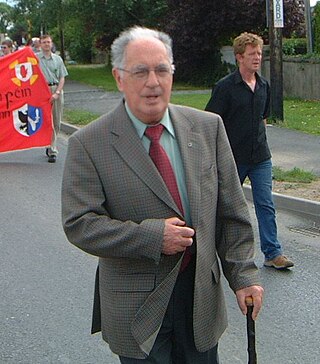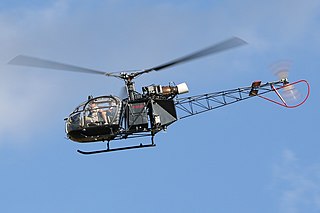
Ruairí Ó Brádaigh was an Irish republican political and military leader. He was Chief of Staff of the Irish Republican Army (IRA) from 1958 to 1959 and again from 1960 to 1962, president of Sinn Féin from 1970 to 1983, and president of Republican Sinn Féin from 1987 to 2009.

An Phoblacht is a formerly weekly, and later monthly newspaper published by Sinn Féin in Ireland. From early 2018 onwards, An Phoblacht has moved to a quarterly magazine format while remaining an online news platform. Editorially the paper takes a left-wing, Irish republican position and was supportive of the Northern Ireland peace process. Along with covering Irish political and trade union issues the newspaper frequently featured interviews with celebrities, musicians, artists, intellectuals and international activists.

Charlie Kerins was a physical force Irish Republican, and Chief of Staff of the Irish Republican Army. Kerins was one of six IRA men who were executed by the Irish State between September 1940 and December 1944. After spending two years on the run he was captured by the police in 1944. Following his subsequent trial and conviction for the 1942 murder of Garda Detective Sergeant Denis O'Brien, Kerins was hanged at Mountjoy Prison in Dublin.
Stephen Hayes was a member and leader of the Irish Republican Army from April 1939 to June 1941.

Mountjoy Prison, founded as Mountjoy Gaol and nicknamed The Joy, is a medium security men's prison located in Phibsborough in the centre of Dublin, Ireland. The current prison Governor is Ray Murtagh.
Saor Éire was a far-left political organisation in the Irish Free State established in September 1931 by communist-leaning members of the Irish Republican Army, with the backing of the IRA leadership. Notable among its founders was Peadar O'Donnell, former editor of An Phoblacht and a leading far-left figure in the IRA. Saor Éire described itself as "an organisation of workers and working farmers".

The executions during the Irish Civil War took place during the guerrilla phase of the Irish Civil War. This phase of the war was bitter, and both sides, the government forces of the Irish Free State and the anti-Treaty Irish Republican Army (IRA) insurgents, used executions and terror in what developed into a cycle of atrocities. From November 1922, the Free State government embarked on a policy of executing Republican prisoners in order to bring the war to an end. Many of those killed had previously been allies, and in some cases close friends, of those who ordered their deaths in the civil war. In addition, government troops summarily executed prisoners in the field on several occasions. The executions of prisoners left a lasting legacy of bitterness in Irish politics.
The Northern campaign was a series of attacks by the Irish Republican Army (IRA) Northern Command between September 1942 and December 1944 against the security forces in Northern Ireland. The action taken by the Northern Irish and the Irish governments as a result of these attacks shattered the IRA and resulted in the former being free from IRA activity by the end of World War II.

Joseph McKelvey was an Irish Republican Army officer who was executed during the Irish Civil War without trial or court martial. He participated in the Anti-Treaty IRA's repudiation of the authority of the Dáil Éireann, the civil government of the Irish Republic declared in 1919 in March 1922, and was elected to the IRA Army Executive. In April 1922, he helped command the occupation of the Four Courts in defiance of the new Irish Free State. This action helped to spark the civil war, between pro- and anti-treaty factions. McKelvey was among the most hardline of the republican side and, briefly in June 1922, became IRA Chief of Staff.

Capital punishment in the Republic of Ireland was abolished in statute law in 1990, having been abolished in 1964 for most offences including ordinary murder. The last person to be executed by the British state on the island of Ireland was Robert McGladdery, who was hanged on 20 December 1961 in Crumlin Road Gaol in Belfast, Northern Ireland. The last person to be executed by the state in the Republic of Ireland was Michael Manning, hanged for murder on 20 April 1954. All subsequent death sentences in the Republic of Ireland, the last handed down in 1985, were commuted by the President, on the advice of the Government, to terms of imprisonment of up to 40 years. The Twenty-first Amendment to the constitution, passed by referendum in 2001, prohibits the reintroduction of the death penalty, even during a state of emergency or war. Capital punishment is also forbidden by several human rights treaties to which the state is a party.

The Mountjoy Prison helicopter escape occurred on 31 October 1973 when three Provisional Irish Republican Army (IRA) volunteers escaped from Mountjoy Prison in Dublin, Ireland, by boarding a hijacked helicopter that briefly landed in the prison's exercise yard. The escape made headlines around the world and was an embarrassment to the Irish coalition government of the time, led by Fine Gael's Liam Cosgrave, which was criticised by opposition party Fianna Fáil. A manhunt involving twenty thousand members of the Irish Defence Forces and Garda Síochána was launched for the escapees, one of whom, Seamus Twomey, was not recaptured until December 1977. The Wolfe Tones wrote a song celebrating the escape called "The Helicopter Song", which topped the Irish popular music charts.

Seán McCool was a prominent Irish Republican and a former chief of staff of the Irish Republican Army. Imprisoned on numerous occasions, both North and South of the border, he embarked on a number of hunger strikes in order to secure release. During the 1930s, McCool was one of the few socialists to remain in the IRA after the Republican Congress's decision to split. He stood as a candidate for the Irish Republican party Clann na Poblachta before leaving them as a result of their decision to go into government with Fine Gael.
Tony D'Arcy was a senior leader in the Irish Republican Army (IRA) who died as a result of a 52 day Hunger-strike at the age of 32.
George Plant was a member of the Irish Republican Army (IRA) who was executed by the Irish Government in 1942.

Harry White was an Irish republican paramilitary. Between 1935 and 1941 White was arrested multiple times and imprisoned in Crumlin Road Jail, Mountjoy Jail, Arbour Hill Prison and the Curragh Camp.
Thomas Harte was the first of seven Irish Republican Army (IRA) members executed by Irish forces in Mountjoy Prison and Portlaoise Prison prisons between 1940 and 1944.
Patrick MacGrath was born into an old Dublin republican family and took part in the 1916 Rising, as did two of his brothers. He was sent to Frongoch Internment Camp after the 1916 Rising and served his time there. He was a senior member of the Irish Republican Army (IRA), hunger striker, IRA Director of Operations and Training during its major bombing/sabotage in England and was the first of six IRA men executed by the Irish Government between 1940–1944. After participating in the Easter Rebellion, MacGrath remained in the IRA, rising in rank and becoming a major leader within the organisation.
Richard (Richie) Goss (1915–1941) was an executed Irish Republican and one of the few Protestant members of the Irish Republican Army (IRA) in the 1940s. Goss was a leader in a major bombing and sabotage campaign in England (1939–40).

Jack "Sean" McNeela was a senior member of the Irish Republican Army (IRA) from Ballycroy, County Mayo, Ireland. McNeela was one of 22 Irish republicans who died on hunger-strike. As a young man, McNeela was an athlete in County Mayo and participated in Gaelic games. He came from a family of four brothers and two sisters. His brother Paddy was also active in the IRA and held the position of Quartermaster general in Dublin.
Seán Harrington (1912–1978) was an Irish republican who later became Chief of Staff of the Irish Republican Army.











